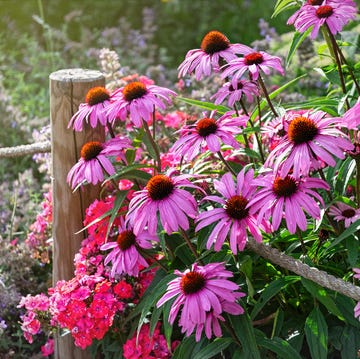Nothing captures the essence of Mother Nature's beauty quite like wildflowers. Visit the countryside and you'll see common types of wildflowers like poppies, daisies, and foxglove in all their glory. But guess what? You can grow them right in your own backyard. One of the great joys of wildflower gardens is that they are low maintenance. Once established, native wildflowers often require minimal intervention to thrive in their habitat.
"Wildflowers allow gardeners to connect with nature, right in their yard," says Nancy Awot-Traut, a horticulture expert at Burpee Gardening. "They not only add natural beauty and diversity to the landscape but also support local ecosystems by providing essential habitat and food sources for pollinators, birds, and other wildlife. By cultivating wildflowers, you also reduce the need for chemical inputs such as fertilizer and pesticides."
Whether you're aiming to attract pollinators, add vibrant colors, or simply enhance your outdoor oasis, cultivating a wildflower garden can be an incredibly rewarding experience. Feeling inspired? Keep reading to learn how to grow the best wildflower garden in your own yard and pick up a few helpful gardening tips from experts.
Pick Your Location
Here are a few things to keep in mind as you begin. First, pick a sunny area with well-draining soil. Most wildflowers need full sun, meaning six or more hours of direct sunlight per day. There are some wildflowers like black-eyed Susan and shasta daisies that can accept partial shade, but most require full sun. You can also grow wildflowers in planters if you only have a small designated space with that much sunlight.
Next, loosen and till the soil and remove weeds before planting. Wildflowers are pretty resilient by nature and can grow in poor soil quality, but consult your seed packets for more information. You may need to add fertilizer or compost to help them grow.
Choose and Plant Your Flowers
"Wildflower gardens can be relatively easy to maintain if you choose the right plants," says Sally McCabe, the associate director of community education for the Pennsylvania Horticultural Society. "Whenever possible, find wildflowers that are native to your region. They require minimal watering once established, as native wildflowers are adapted to your region's rainfall. They don't need fertilizer, as they get nutrients from the soil."
Early spring and fall are typically the best times to sow wildflower seeds. In many regions, this timing allows seeds to establish themselves before the heat of summer or the cold of winter sets in. However, the exact timing can vary depending on your plant hardiness zone and the specific species of wildflowers you're planting. Be sure to research the ideal planting window for your area and your selected flowers to maximize their chances of success.
No matter when you start planting your wildflowers, Awot-Traut recommends incorporating a mix of annuals and perennials. "This will ensure continuous blooms throughout the season," she says. "Annuals provide quick color while perennials offer long-time color." By selecting a diverse mix of wildflowers, you can enjoy long-lasting beauty in your garden.
As you go to plant, consult the seed packets on the amount of seeds to use for your designated area. Scatter the seeds evenly and lightly cover them with soil. Keep the soil consistently moist until the seeds germinate, about ten to 21 days, and then you can water once per week or so.
Maintain Your Garden
While wildflower gardens are low maintenance, they may also present some challenges. These include slow initial establishment, unpredictable growth, and the potential for certain species to spread beyond intended areas and outcompete other plants. And without proper management, other plants can compete with wildflowers for essential resources like sunlight, water, and nutrients, ultimately hindering wildflowers' growth.
"You will always need to do some weeding, especially in the first year, to control competition from other plants," McCabe suggests. You will also need to water the plants, particularly at the beginning. But with careful selection and maintenance, your wildflowers should grow naturally without excessive interference. That will allow you to enjoy a thriving wildflower garden for years to come.

Tierney McAfee is a freelance writer and Country Living and The Pioneer Woman contributor who covers entertainment, holiday & entertaining, food & drinks, design ideas, DIY, and more.















